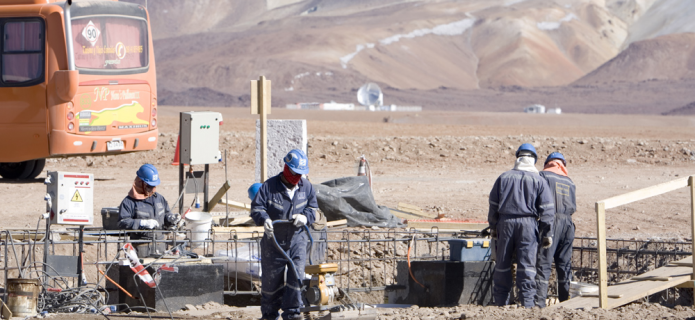Breathing stars
3 April, 2007 / Read time: 3 minutes
Located 5000m above sea level, in the Chilean Atacama desert, ALMA is the highest site for ground-based astronomy. This property will be put to good use for academic institutions in Chile and in Europe in order to study the human response to extreme altitude conditions.
During a ceremony held on 2 April in Antofagasta, representatives from ALMA, ESO and the University of Antofagasta have officially launched a collaborative agreement that also involves the University of Chile and the University of Copenhagen (Denmark). The newly established cooperation aims at contributing to the promotion of teaching, scientific research, and the expansion of altitude physiology and medicine or other related areas considered appropriate.
"An increasing number of people are periodically exposed to brisk changes in altitude, and not only for astronomical research," said Jacques Lassalle, the ALMA Safety Manager. "Short stays at high altitude alternate with short stays at sea level but the corresponding shifts are very often established by agreement, and not based on scientific arguments. With this project, we aim at improving our knowledge and procedures in order to protect the long term health of the operators, engineers, and scientists as well as ALMA visitors of all ages and all physical conditions," he added.
Around the world, a large number of people systematically commute between sea level and high altitude, for example when working in mountainous mines. This poses stringent conditions that may affect health, wellbeing and working performance. Some of the factors in question are the shift work regime, the perturbation of circadian rhythms, fatigue, family and social isolation, commuting, intermittent high altitude exposure and other environmental challenges such as low temperatures.
"An adequate acclimatisation to 2,500m altitude requires around two weeks, and we can thus speculate that going to 5,000m would require more than one month to achieve complete acclimatisation," said Professor Juan Silva Urra, from the University of Antofagasta.
However, short and long term effects of regular commuting between sea level and high altitude have scarcely been studied in biomedical terms. Scientifically based guidelines for appropriate preventive handling and care under these conditions are lacking and the new study will help bridging this gap.
Among the studies to be done, some involve continuous monitoring of the human body through portable devices, including measurements of hormone levels and application of psychometric tests. All measurements at 5,000m will be carried out on a voluntary basis, under strict safety protocols, with the presence of a doctor from the investigation team, paramedic personnel form ALMA and an ambulance.
The symptoms of Acute Mountain Sickness are headache, sicknesses, gastrointestinal inconveniences, fatigue and insomnia that, depending on their intensities, decrease the capacity to carry out the most routine activities.
The valuable data collected will enhance our knowledge of human physiology in extreme environments, generating recommendations that will improve wellbeing and health not only in high-altitude observatories, but also in mining and Antarctic personnel.
"We are pleased that ALMA is contributing to other disciplines, like medicine, even before the antennas begin to explore the universe," said Felix Mirabel, ESO's representative in Chile. "This outstanding long-term research that will provide crucial information of human physiology to experts worldwide, has been made possible thanks to the combined effort of Chilean and European universities, in collaboration with ALMA".
